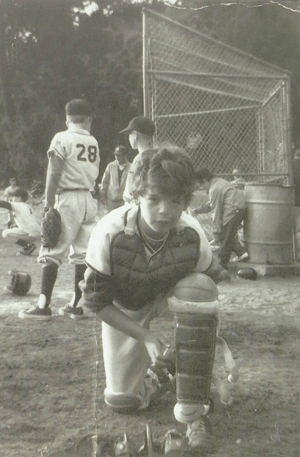- About
- Events
- News
Search Our Website

Leadership Lessons from a Fourth-Grade Catcher
July 21 2015
I started training as a CEO at nine years old. I just didn’t know it.
When I was a kid, my uncle was the manager of the AAA minor league team of the San Francisco Giants. As a result, I got to visit the 1968 Giants’ clubhouse. I met Willie Mays, Jesus Alou, Willie McCovey, Juan Marichal and Bobby Bonds (Barry’s dad). I watched them ice down, joke around and (some of them) smoke cigarettes. They gave me autographed balls and told me to practice hard and play well. So, being a kid, that is precisely what I did. And what came of it were the first CEO lessons I ever learned.
Some of my best leadership lessons of my life took place that year when I played catcher for the Our Lady of Mercy fourth-grade team. I played catcher because the gear was cool, I liked being in the action and no one else would do it. I soon found out why they call the catcher the “on-field” manager – even when you are only four feet tall.
So from my sketchy memory banks, I share the top four leadership lessons learned behind the plate that year – lessons I have used over the decades as a CEO.
A leader has to over-communicate if he wants everyone on the same page.
It was my job to let everyone on the team know what was going on: how many balls and strikes, how many outs, when the ball was coming, etc. This was especially important with Jimmy Kesterson, who often had his hand down the front of his pants, accompanied by a slight lack of concentration. A leader has to communicate the plan, the score, and the role each team member should be playing – and they need to communicate it over and over and over. Assuming the players “just know” what to do is bad. I had to yell out instructions several times each inning. When you communicate to excess, a common vision emerges, along with better performance on the field (or in your company).
Don’t let a little situational discomfort put you at an even higher risk.
Catchers wear a cup. That’s it. But for me, I didn’t like the feeling. It chafed. It rubbed and it was distracting when I was in the crouch…until the day Binker Murphy threw his scorching fastball. It hit the corner of the plate and bounced directly up into my crotch. Now, I don’t know about you, but when you are nine, and the girl you really like is in the stands, the idea of grabbing your balls in a public forum is a real dilemma. So I grabbed my knee instead. I’m rolling on the ground thinking to myself, Please God, make this stop hurting and I’ll wear a cup 24-7. The lesson was simple: leaders have to experience ongoing levels of discomfort all the time. Chafing is part of the deal. Discomfort is the state of leadership. The consequences of avoidance are generally more severe if you try to bypass the discomfort. Get used to it or find yourself with your knee in your hand.
You have to give a lot of individual coaching to your key players — both when they are doing great and when they are sucking badly.
Your key players determine who wins. On a nine-person team (or crew), you might have three to four people who are going to make the difference. In my little league days, one of those people was always the pitcher. When he had a bad day, we all had a bad day. A fourth-grade kid who walks batter after batter starts to lose it. He gets close to tears, and it doesn’t help that his parents are in the stands. The coach can’t do anything in that situation, either, so I would run the ball out to him on the mound as often as I could (often with the umpire yelling at me to get back behind the plate). I’d tell that pitcher whatever he needed to hear: that he was the greatest, maybe, or that he needed to get mad. The lesson is simple. Read the player and give them the individual coaching and attention that they need. It’s possible for them to do it on their own, but they can perform so much better with a little help from you. The same is true for when they’re killing it and doing a great job. At those times, remind them that they are demonstrating their true potential. Build their confidence. Make them set the benchmark for their future performance.
Don’t avoid confrontation.
Catchers own the plate. If you block that plate, you’re going to get hit. The physics are pretty basic. Imagine this scenario: a kid with a running start from third base of probably 70 feet is barreling directly toward me as fast as he can. His only goal is to score a run. Meanwhile, I’m standing stock-still, waiting for a throw from Sean Wallace in right field, and I cannot look at this guy coming down the l ine. Everyone is counting on my courage a nd resolve at that moment. All the gear in the world won’t compensate for me getting “Buster Poseyed.” But you have to stand up and take it. Leaders do not shy away from confrontation. Leaders do not back down at the crucial moment. Leaders often have to take one for the team. Leaders cannot lose their concentration at the moment of key business impact. And frankly, sometimes the leader has to lower their shoulder and smash the tag into someone’s face to get everyone’s attention. It may only be 1% of t he t ime on t he field, but you will be measured by those moments for a long time afterwards.
When I look at the photo that accompanies this article, I don’t see a kid really having fun. That kid doesn’t look like he’s living the “everyone gets a trophy” sports experience. The look in the eyes is pretty serious. I don’t remember that day, or most of the games I played, for that matter. But I do remember those simple lessons, long after any thrill or disappointment with wins and losses have faded from memory. These same lessons are key to the success of our leaders today, especially foremen and superintendents. Often we send players onto the field without a clear idea of the requirements of the position and the tools to succeed while doing it. We forget to coach them and give them the feedback necessary to improve. They too are our on-field managers. In order to create a winning environment, the foundational elements of leadership are not complex. The key is remembering to apply these simple principles and reinforce them regularly.
Simply put, after reading your company P&L sheet, you don’t want to find yourself rolling on the ground holding your knee.
Mark Breslin is a strategist and author of several books, including most recently, The Five Minute Foreman: Mastering the People Side of Construction. Visit his website at www.breslin.biz or contact him at (925) 705-7662.

© Copyright 2025 TAUC. All Rights Reserved.
Site created by Top Shelf Design

